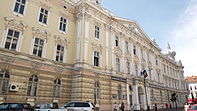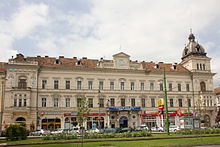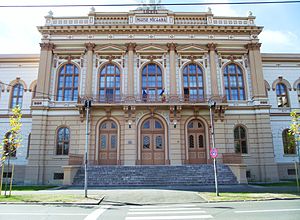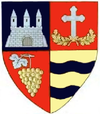Arad, Romania
Arad | |
|---|---|
Municipality | |
        From top, left to right: Arad City Hall, Cenad Palace, The Red Church, St. Anthony of Padua Church, Moise Nicoara National College, Ioan Slavici National Theatre, Statue of St. Nepomuk's, Aurel Vlaicu University | |
|
| |
| Country | |
| County | Arad County |
| Status | Municipality |
| Government | |
| • Mayor | Gheorghe Falcă (Democratic Liberal Party) |
| Area | |
| • Total | 46.18 km2 (17.83 sq mi) |
| Elevation | 117 m (384 ft) |
| Population (2011 census)[1] | |
| • Total | 159,704 |
| • Density | 3,500/km2 (9,000/sq mi) |
| Time zone | UTC+2 (EET) |
| • Summer (DST) | UTC+3 (EEST) |
| Postal code | 31xxx |
| Area code | (+40) 02 57 |
| Vehicle registration | AR |
| Website | primariaarad.ro |

Arad (Romanian pronunciation: [aˈrad] ⓘ; Hungarian: Arad; Serbian: Арад/Arad) is the capital city of Arad County, historically situated in the region of Crişana, and having recently extended on the left bank of the Mureș river, in Banat region of western Romania.
An important industrial center and transportation hub on the Mureș River, Arad is also the seat of a Romanian Orthodox archbishop and features two universities, a Romanian Orthodox theological seminary and a training school for teachers. It had one of the first music conservatories in Europe.[2][3] The city has a population of 159,704, making it the 12th largest city in Romania. Arad is the third largest city in the western part of the country, behind Timișoara and Oradea.
History
Arad was first mentioned in documents in the 11th century. The Mongol invasion of the Kingdom of Hungary in 1241 showed the importance of the fortifications on this place, to which were added in the second half of the 13th century more stone fortresses at Șoimoș, Șiria, and Dezna. The Ottoman Empire conquered the region from Hungary in 1551 and kept it until the Peace of Karlowitz of 1699. Arad became an eyalet center, which comprised the sanjaks of Arad, Lugoj, Kacaș, Beşlek and Yanova from 1660 till 1687, when it was captured by Austrians (Serbian Militia under command of Subota Jović) during Ottoman-Habsburg wars (1683–1699). After 1699, the city was ruled by the Habsburg Monarchy. According to 1720 data, the population of the city was composed of 177 Romanian families, 162 Serbian, and 35 Hungarian.[4]
The first Jew allowed to settle inside the city was Isac Elias in 1717.[5] Eventually the Jewish population of Arad numbered over 10,000 people, more than 10% of the population, before the Second World War.[6]
The new fortress was built between 1763 and 1783. Although it was small, it proved formidable having played a great role in the Hungarian struggle for independence in 1849. The city possesses a museum containing relics of this war of independence.
Courageously defended by the Austrian general Berger until the end of July 1849, it was captured by the Hungarian rebels, who made it their headquarters during the latter part of the Hungarian Revolution of 1848. It was from Arad that Lajos Kossuth issued his famous proclamation (11 August 1849), and where he handed over the supreme military and civil power to Artúr Görgey.
The fortress was recaptured shortly after the surrender at Világos (now Şiria, Romania), with the surrender of general Artúr Görgey to the Russians. It became an ammunition depot. Thirteen rebel generals were executed there on 6 October 1849, by order of the Austrian general Julius Jacob von Haynau. These men are known collectively as the 13 Martyrs of Arad, and since then Arad is considered the "Hungarian Golgotha". One of the public squares contains a martyrs' monument, erected in their memory. It consists of a colossal figure of Hungary, with four allegorical groups, and medallions of the executed generals.
Arad enjoyed great economic development in the 19th century. In 1834 it was declared a "free royal town" by Emperor Francis I of Austria.
Aradu Nou / Neu Arad / Újarad ("New Arad"), situated on the opposite bank of the Mureș river, is a neighborhood of Arad, to which it is connected by the Trajan bridge. It was founded during the Turkish wars of the 17th century. The works erected by the Turks for the capture of the fortress of Arad formed the nucleus of the new settlement.
In 1910, the town had 63,166 inhabitants: 46,085 (73%) Hungarians, 10,279 (16.2%) Romanians, 4,365 (7%) Germans.[7]
Chronology
- 1028 – First time the area was mentioned.
- 1078 – 1081 – The first mention of the town
- 1131 – Arad is mentioned in The Painted Chronicle From Vienna.
- 1526 – Following the Hungarian defeat in the Battle of Mohács, John Zápolya, elected King of Hungary, establishes the Eastern Hungarian Kingdom in Partium and Transylvania.
- 1541 – After the fall of Buda to the Ottomans, the city passes under the administration of the Autonomous Principality of Transylvania.
- 1551 – 1595 – The town was occupied and administered by the Ottoman Empire, the former county being divided into three sangeacs.
- 1553 – 1555 – Between these years, the Ottomans built the first fortress of the city on the northern bank of the river Mureș.
- 1595 – Transylvanian troops cleared the lower valley of the Mureș, thus the city of Arad was reintegrated in the Transylvanian Principality.
- 1599 – After the victory of Mihai Viteazu's troops at Șelimbăr, the city enters under the Voivode's authority until 1601 when Gabriel Bethlen gives the Mureș valley back to the Ottomans.
- 1683 – After the failure of the Ottoman siege of Vienna, Habsburg troops conquer the city in 1687.
- 1699 – After the Peace of Karlowitz, the Mureș river valley became the new border between The Habsburg Empire and the Ottoman Empire, thus the city became the headquarters of the frontier guard troops.
- 1702 – The furriers' guild was registered – the oldest one.
- 1715 – Camil Hofflich, a minorite monk, set up the first school – German language.
- 1724 – First German settlers from Franken come to the south of the river and establish Neu Arad.
- 1732 – Almost the entire area of the county was donated to Rinaldo of Modena, who, later disgraced in 1740, lost it to the Austrian crown.
- 1765 – 1783 – The new fortress was built, in Vauban-Tenaille style.
- 1781 – Following the building interdiction in the city, providing clear gunshot fields, the Empire considered moving the city in the Zimand pusta; subsequently Emperor Joseph II gave up the idea.
- 1812 – The foundation of Preparandia – the first Romanian pedagogy school in Transylvania.
- 1817 – The Hirschl Theatre was built.
- 1818 – The safety perimeter of the fortress was reduced from 2 kilometers as put out in 1783, to just 500 m.
→ 1868 – Romanian poet Mihai Eminescu came to Arad as a prompter for Matei Millo's theatre company.
- 1833 – The sixth European Music School was set up in Arad, after Paris, Prague, Brussels, Vienna and London – Aradi Zenede/Arader Musik Conservatorium.
- 21 August 1834 – Arad obtained the "Free Royal Town" statute.
→ 1846 – Hungarian composer and piano virtuoso Franz Liszt performed.
- 6 October 1849 – 13 generals of the Hungarian revolutionary army executed.
→ 1847 – Johann Strauss the Son performed.
- 1851 – Inauguration of the Neumann family alcohol and yeast factory.
- 1858 – Inauguration of the central train station.
- 1874 – The original building of the Theater was built.
- 1876 – The Administrative Palace was built.
→ 1877 – Pablo Sarasate and Henryk Wieniawski performed.
- 1890 – The Philharmonic Society of Arad was founded.
- 1897 – The Cenad palace was built.
- 1913 – The edifice of today's Palace of Culture and site of the Philarmonics was built on the river embankment.
→ 1922 – Romanian composer and violin virtuoso George Enescu performed.
→ 1924 – Hungarian composer Béla Bartók performed.
- 1892 – The Weitzer Wagon Factory starts producing railway cars. Since 1903 it built the first successful series of petrol driven railcars in Europe.
- 15 August 1899 – The first official football game was held.
- 1906 – Arad-Podgoria Narrow Railway was opened with petrol railcars.
- 1909–1914 – Production of motorcars by (MARTA), a subsidiary of Austro-Daimler. MARTA was the acronym of Magyar Automobil Részvény Társaság Arad (Hungarian automobile joint stock company Arad)
- 1911–1913 – Arad-Podgoria Narrow Railway was electrified. Apart from factory rails and urban trams, it was the third electric railway in Hungary and the sixth one in Habsburg Monarchy. In 1920, it should become the first electrical railway of Romania.
- 1918 – Arad becomes the headquarters of The Romanian National Central Council, the provisional government of Transylvania, and also its unofficial capital.
- 1920 – Under the Treaty of Trianon, Arad was ceded to Romania.
- 1921 – Weitzer Wagon Factory and MARTA merge to ASTRA Automobile & Wagon Factory
- 1937 – Arad was the most important economic center in Transylvania and occupied the fourth position in Romania[citation needed]
- 1980es – Astra Automobile & Waggon Factory was Europe's largest manufactorer of freightcars.
- 1989 – Arad was the second town in Romania to rise against the communist regime of Nicolae Ceaușescu, with considerable violence.
- 1996/98 Astra Automobile & Waggon Factory was split in Astra Vagoane Arad (production of freightcars), Astra Vagoane Călători (production of passenger railcars), and Astra Buses.
- 1999 – The Arad Industrial Zone was inaugurated.
- 2011 (November) – Astra Vagoane Arad was bankrupt.
Population
| Historical population of Arad | |||||||||||||
| Year | Population | ||||||||||||
|---|---|---|---|---|---|---|---|---|---|---|---|---|---|
| 1900 | 53,903[8] | ||||||||||||
| 1912 census | |||||||||||||
| 1930 census | |||||||||||||
| 1948 census | |||||||||||||
| 1956 census | |||||||||||||
| 1966 census | |||||||||||||
| 1977 census | |||||||||||||
| 1992 census | |||||||||||||
| 2002 census | |||||||||||||
| 2011 census | |||||||||||||
According to the 2011 census, the municipality of Arad was home to 159,704 inhabitants. The ethnic split of the city was as follows: 126,075 Romanians (85.19%); 15,695 Hungarians (10.06%); 2,535 Romani (1.71%); 1,256 Germans (0.84%); and 2,116 of other nationalities (1.22%). [1]
The principal religious groups were the Romanian Orthodox (72.7%), Roman Catholic (12.1%), Baptist (4.5%), Pentecostal (4.4%), Reformed (3.1%), and Greek-Catholic (1.1%) churches.
Climate
Arad has a continental climate with cool and damp winters. The summers are warm to hot. In the summer months of June, July and August there are 60 days above 32 °C (90 °F). The Köppen Climate Classification subtype for this climate is "Cfb" (Marine West Coast Climate/Oceanic climate).[9]
| Climate data for Arad, Romania | |||||||||||||
|---|---|---|---|---|---|---|---|---|---|---|---|---|---|
| Month | Jan | Feb | Mar | Apr | May | Jun | Jul | Aug | Sep | Oct | Nov | Dec | Year |
| Record high °C (°F) | 18 (64) |
18 (64) |
26 (79) |
28 (82) |
32 (90) |
34 (93) |
38 (100) |
37 (99) |
36 (97) |
30 (86) |
21 (70) |
17 (63) |
38 (100) |
| Mean daily maximum °C (°F) | 1 (34) |
4 (39) |
16 (61) |
21 (70) |
23 (73) |
25 (77) |
30 (86) |
28 (82) |
24 (75) |
17 (63) |
9 (48) |
5 (41) |
15 (59) |
| Daily mean °C (°F) | −1 (30) |
1 (34) |
6 (43) |
10 (50) |
16 (61) |
18 (64) |
20 (68) |
20 (68) |
17 (63) |
11 (52) |
5 (41) |
0 (32) |
10.2 (50.4) |
| Mean daily minimum °C (°F) | −3 (27) |
−2 (28) |
1 (34) |
7 (45) |
13 (55) |
15 (59) |
16 (61) |
14 (57) |
11 (52) |
6 (43) |
0 (32) |
−2 (28) |
6 (43) |
| Record low °C (°F) | −25 (−13) |
−21 (−6) |
−15 (5) |
−7 (19) |
−1 (30) |
2 (36) |
5 (41) |
4 (39) |
0 (32) |
−11 (12) |
−12 (10) |
−17 (1) |
−25 (−13) |
| Average precipitation mm (inches) | 22.8 (0.90) |
18.9 (0.74) |
22.7 (0.89) |
41.5 (1.63) |
39.4 (1.55) |
63.2 (2.49) |
44.9 (1.77) |
39.7 (1.56) |
40.0 (1.57) |
28.2 (1.11) |
29.6 (1.17) |
31.3 (1.23) |
422.2 (16.62) |
| Average rainy days | 11 | 11 | 11 | 10 | 12 | 11 | 9 | 8 | 7 | 9 | 12 | 12 | 123 |
| Mean monthly sunshine hours | 62 | 84 | 124 | 150 | 248 | 270 | 279 | 279 | 210 | 155 | 60 | 62 | 1,983 |
| Source: Weatherbase[10] MSN Weather[11] BBC Weather [12] | |||||||||||||
Economy
With a rich industrial and commercial tradition, Arad is one of the most prosperous cities in Romania. Thanks to numerous investments in industry and commerce, Arad has a booming economy.[citation needed]
The main industries are: railroad cars, food processing, furniture and household accessories, equipment for the car industry, electric components, instrumentation, clothing and textiles, and footwear.
Transport

Arad is the most important trans-European road and rail transportation junction point in western Romania, included in the 4th Pan-European Corridor linking Western Europe to South-Eastern European and Middle Eastern countries. The city has an extensive tram network and several bus lines covering most of the city's neighbourhoods and suburbs. Arad International Airport (IATA: ARW, ICAO: LRAR), with the largest and most modern cargo terminal in western Romania, is situated only 4 km west from central Arad and is directly connected to the Arad west bypass road, part of the A1 Motorway.
Employees by occupation
- Industry - 41.5%
- Commerce - 13.75%
- Transport and telecommunications - 9.27%
- Construction - 7.92%
- Education - 5.99%
- Health and social services - 5.14%
- Utilities - 3.16%
- Public administration - 2.28%
- Agriculture - 1.97%
- Credit and insurance institutions - 1.70%
Districts
- Aradul Nou
- Centru
- Aurel Vlaicu
- Micălaca
- Grădiște
- Alfa
- Bujac
- Confectii
- Functionarilor
- Gai
- Parneava
- Sânnicolaul Mic
- Colonia
- Subcetate
Tourist attractions
Architectural monuments


- The Fortified Town of Arad is one of the Transylvanian fotresses built in the Vauban star-shaped style, in the second half of the 18th century. It was used as a prison for the rebels led by Horia, Cloșca, and Crișan
- Administrative Palace, built in 1872-74, renaissance architecture
- Ioan Slavici Classical Theatre, built in 1874, neoclassical architecture, architect Anton Czigler
- Neumann Palace, built in 1891, eclecticism
- Judiciary Palace, built in 1892, eclecticism
- Cenad Palace, built in 1894, eclecticism and neoclassical architecture
- National Bank Palace, built in 1906, neoclassical architecture
- Bohuș Palace built in 1910, Vienna Secession. (For the first time in Arad, reinforced concrete was used)
- Szantay Palace, built in 1911, Vienna Secession
- Cultural Palace, built in 1913, neoclassical, gothic, renaissance architecture, and Corinthian capitals
- Cloșca Street, Vienna Secession
Historic buildings
- The House with Cannon Balls, built in 1800. Its name derives from the fights between 1848 and 1849. Seventeen cannonballs are incorporated in its walls.
- The High Teacher Training School (Clădirea Preparandiei), the first school for Romanian-language teachers from Transylvania, 1812
- The House with the Padlock, built in 1815
- The Old Theatre (Hirschl), built by Jacob Hirschl in 1817, the oldest stone theatre in Romania
- Water Tower, built in 1896, medieval dungeon architectural style
- The Old Custom House, built in 1907, used as a customs point for goods entering the Arad markets
Monuments
- The Statue of St. John of Nepomuk, raised in 1729, baroque sculpture
- The monument of the Holy Trinity, raised in 1746 to commemorate the plague that swept the town in 1738-1740

- Reconciliation Park
- The Statue of Liberty, raised in 1890 by György Zala in the memory of the heroes of the Hungarian revolutionary army
- The Arch of Triumph, raised in 2004 by Ioan Bolborea in memory of the heroes of the 1848 - 1849 Romanian Revolution (fighting against the Hungarians)
- Martyrs' Cross, raised in 1936, in memory of the priests martyred between November 1918 and spring 1919
- The Bust of Vasile Goldiș (1862–1934)
- The Bust of Moise Nicoară (1784–1861)
Religious tourism
- The "St. Peter and Paul" Serbian Church, raised in 1698-1702, early Baroque architecture
- "St. Simon" Monastery , raised in 1762, Baroque architecture
- "St. Anthony of Padua" Church (Roman Catholic). The Order of Minorite Monks raised this cathedral in 1904, in a renaissance architecture style
- The "Birth of Saint John the Baptist" Cathedral (Romanian Orthodox), raised in 1862-1865, Baroque architecture, architect Antoniu Czigler. The mural painter, Anastase Damian, started his work in 1957 and finished it one year later

- The Red Church (Evangelical-Lutheran), built in 1906, Neo-gothic architecture
- The Neologue Synagogue, built in 1834, Greek, Tuscan architectural style
- Holy Trinity Cathedral, built between 1991 and 2006, the new cathedral in Byzantine style
Recreational tourism
- Neptun Swimming Place, known in Romanian as "Ştrandul Neptun" is the second biggest Swimming Place in Europe, situated near a river. Due to its size and its recreational activities Strandul Neptun has over 3 millions visitors annually, according to Recons Arad.
- Mureș Floodplain Natural Park (Lunca Mureșului Natural Park)
- The Ceala Forest with Măltăreț Lake and Mureș Isle
- The Vladimirescu Forest
- Ghioroc Lake
- Miniș - Măderat Vineyard, situated about 30 km east of Arad
- Moneasa resort, situated about 100 km, or 62 miles, ENE from Arad
Culture and education
Schools
Arad has two universities, the private "Vasile Goldiş" Western University, founded in 1990, and the public Aurel Vlaicu University founded in 1991. Also the "Spiru Haret" long-distance studies University has a branch in Arad.
There are about two dozen high schools, some of the more famous being the Moise Nicoară National College, the Pedagogical High School "Dimitrie Țichindeal", "Elena Ghiba-Birta" National College, the Economics College, the Technical College for Constructions and Environmental Protection Arad, and the Vasile Goldiș theoretical lyceum. High schools in minority languages include the Hungarian Csiky Gergely College and the German Adam Müller-Guttenbrunn theoretical lyceum.

Cultural life
- Arad State Theater, hosting an annual Classical Theater Festival
- International Underground Theater Festival
- Philharmonic orchestra
- Puppet theater
Museums and exhibitions
- Arad Museum Complex
- History Department
- Natural Sciences Department
- Art Department
- Vasile Goldiş Memorial Museum
- Doina and Baruțu Arghezi Art Collection
- Delta Gallery, with three major events of Arad artistic life: The International Biennial Drawing Saloon, The Biennial Small Sculpture Saloon, The Annual Art Saloon.
- Alfa Gallery
- Clio Gallery
- Water Tower Gallery
- Takács Gallery
- Carola's Gallery
- Expo Arad International, The Exhibition Centre of the Chamber of Commerce, Industry and Agriculture of the County of Arad, the only purely exhibitional arena in western Romania and second only to Romexpo.
International relations
Twin towns—Sister cities
 Atlit, Israel
Atlit, Israel Fushun, China
Fushun, China Gyula, Hungary
Gyula, Hungary Hódmezővásárhely, Hungary
Hódmezővásárhely, Hungary Givatayim, Israel
Givatayim, Israel Zrenjanin, Serbia
Zrenjanin, Serbia Pécs, Hungary
Pécs, Hungary
Partner cities
 Kirklees, England, United Kingdom
Kirklees, England, United Kingdom Ditzingen, Germany
Ditzingen, Germany Würzburg, Germany
Würzburg, Germany Trenčín, Slovakia
Trenčín, Slovakia Tatabánya, Hungary
Tatabánya, Hungary
Sports
The UTA Arad (formerly ITA) football team was founded in 1945 and has won six Romanian championships and two Romanian Cups. As of the 2009-10 season, it plays in the second national league, Liga II. The team is the most successful team from Romania that is not based in Bucharest, after Steaua and Dinamo[citation needed]; it is the 3rd more successful modern team in the country and 4th counting Venus Bucharest, a team from the Inter-War period. The team's most notable performance on the international stage is the elimination from the European Champions Cup of Ernst Happel's Feyenoord in the 1970–71 season, when the Dutch team were defending European champions and later won the Intercontinental Cup.
In basketball, the women's ICIM and the men's West Petrom teams have national prominence, their record including some recent national championship wins (ICIM in 1998 through 2001, West Petrom in 2001 and 2002). In men's water polo, Astra Arad also plays in the first division. The men's rugby team Contor Group Arad plays in the National Rugby League, reaching the playoff final in 2006.
World Champion and Olympic medalist in gymnastics Emilia Eberle was born in Arad.
References
- This article incorporates text from a publication now in the public domain: Chisholm, Hugh, ed. (1911). "Arad". Encyclopædia Britannica (11th ed.). Cambridge University Press.
Notes
- ^ a b "Population at 20 October 2011" (in Romanian). INSSE. 5 July 2013. Retrieved 5 July 2013.
- ^ Dorin Frandeş, Spaţii arădene care au găzduit muzică – Piteşti : Nomina 2011 ISBN 978-606-535-327-5;
- ^ Consiliul Judeṭean Arad - Arad, spirit și cultură
- ^ Dr Dušan J. Popović, Srbi u Vojvodini, knjiga 2, Novi Sad, 1990, page 326.
- ^ Lakatos Otto - Aradi története
- ^ Template:Ro icon "Sinagoga din Arad - Misterul din spatele usilor : Stiri Arad," aradnet.ro (13 mar 2008). Retrieved 11-08-2013.
- ^ Atlas and Gazetteer of Historic Hungary 1914, Talma Kiadó
- ^ Encyclopædia Britannica Eleventh Edition
- ^ Climate Summary for Arad
- ^ "Weatherbase: Historical Weather for Arad, Romania".
- ^ "MSN Weather Averages for Arad".
- ^ "BBC Weather Averages for Arad". BBC News.
- ^ Galeria orașelor înfrățite și partenere




